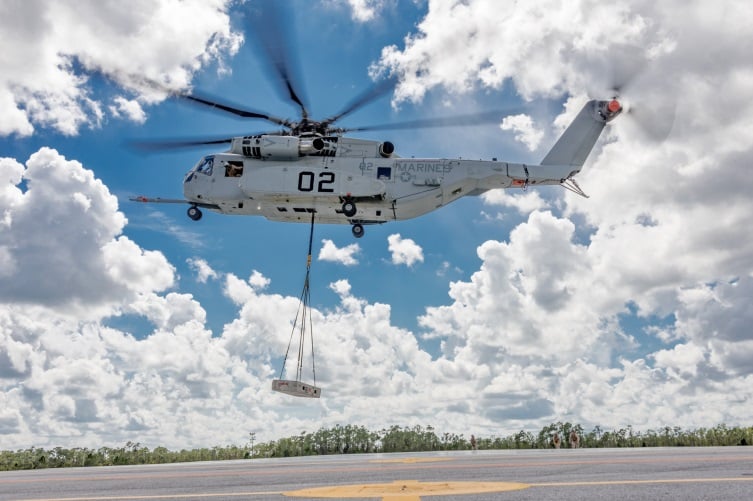
NATIONAL HARBOR, Md. – The Pentagon today formally approved the Marine Corps’ CH-53K Super Stallion heavy lift helicopter program to move into production.
The aircraft, which replaces the CH-53E, provides about three times the external lift capability, greater ranges and better reliability for the Marine Corps, in support of the service hauling heavier equipment at greater standoff distances from ship to shore.
“On April 4, 2017, the Senior Official Performing the Duties of the Under Secretary of Defense for Acquisition, Technology, and Logistics (USD(AT&L)) approved the Navy’s request for the CH-53K King Stallion program to enter into the Production and Deployment phase,” Pentagon spokesman Cmdr. Patrick Evans said in a statement.
“From the review, the Senior Official Performing the Duties of the USD(AT&L) determined that the program is ready for the Production and Deployment phase.”
“The team has worked really hard to ensure we could get here, to Milestone C, and to begin low-rate initial production,” Deputy Commandant for Aviation Lt. Gen. Jon Davis said in a statement.
“I’m very proud of all of them, and I’m looking forward to getting the most powerful heavy-lift helicopter ever designed into the hands of our Marines.”
Ahead of that Milestone C acquisition decision, program manager Col. Henry Vanderborght told reporters at the Navy League’s annual Sea-Air-Space exposition that “there are so many improvements that have been made to this aircraft” to boost lift capability, safety, reliability and maintainability.
“This capability right here is really going to be an incredible step increase for the warfighter and the [Marine Air-Ground Task Force],” he said.
“Basically 3X the lift capability in the same ambient conditions as the legacy aircraft, meaning the K will be able to lift three times more than the 53E in that 110 nautical mile environment, 103 degrees Fahrenheit at sea level with [a landing zone] of 3,000 (feet) … above sea level, with 91.5 Fahrenheit at that LZ. That’s basically our key performance parameter.”
Beyond the sheer numbers, Vanderborght said automation, both in the control modes and in tracking and predicting maintenance needs, will make the aircraft safer and easier to operate.
“Basically the 53K will be able to fly to an LZ pretty much hands off and pick up a hover in total brownout conditions – and that’s one of the areas where we’ve lost a lot of aircraft, a lot of Es,” he said.
“So from a safety standpoint, survivability, it’s just incredibly more capable than what we have today, and the Marines pretty much can’t wait to get it.”
He said the new aircraft would cost about the same as its predecessor in operations and sustainment costs, but for that money the Marines would get a much higher sortie generation rate.
A Fleet Common Operating Environment (FCOE), which has been running for years on the CH-53E, collects aircraft maintenance data and ultimately may help the Marines get to a condition-based maintenance environment.
“There’s so much data coming off this airplane, that the idea will be the airplane will tell you when you need to start removing things, when the operator needs to start removing things, and that will save a lot of money and time,” Vanderborght said.
For example, he said, the main rotor gear box on the legacy CH-53E used to be overhauled every 2,000 hours, but a study with FCOE data proved maintainers could overhaul it at 2,400 hours instead.
“What that equates to is five less main rotor gear boxes that we’ve got to pull every year at a savings of about $4.7 million,” the program manager said.
“That’s just one example, there are many others.”
Michael Torok, Sikorsky’s vice president of CH-53K programs, said at the same media briefing that “the amount and magnitude of sensors that are on the aircraft,” plus the computing power in FCOE, “really allows the maintainers, when the aircraft comes back in, to debrief, you stick the [cards] into the laptops and all of that diagnostics on the ground station basically will really focus in on any maintenance that is required. So false removals go down, false alarms go down. Really focuses and reduces mean time to repair. So that automation, that technology is really going to play a significant role” in keeping operations and sustainment costs down.
Torok said the first four CH-53Ks have been “mapping out the rest of the edge of the envelop” for how the aircraft can operate beyond its basic requirement of 27,000 pounds for 110 nautical miles. Additionally, aircraft 5 and 6 are already under contract, and Sikorsky is buying long-lead materials for the first Low-Rate Initial Production contract of two aircraft. Sikorsky’s production line, which will consolidate to their Connecticut facility, will eventually build 24 aircraft a year and reach full-rate production in 2020.
Overall program costs for the CH-53K come to about $87 million per helicopter and $133 million per unit when research and development, spares, and other program costs are included. The first four helos that had been used for testing will deliver to the Marine Corps next year, with LRIP aircraft delivering starting in 2021, the Marine Corps said in its statement.





